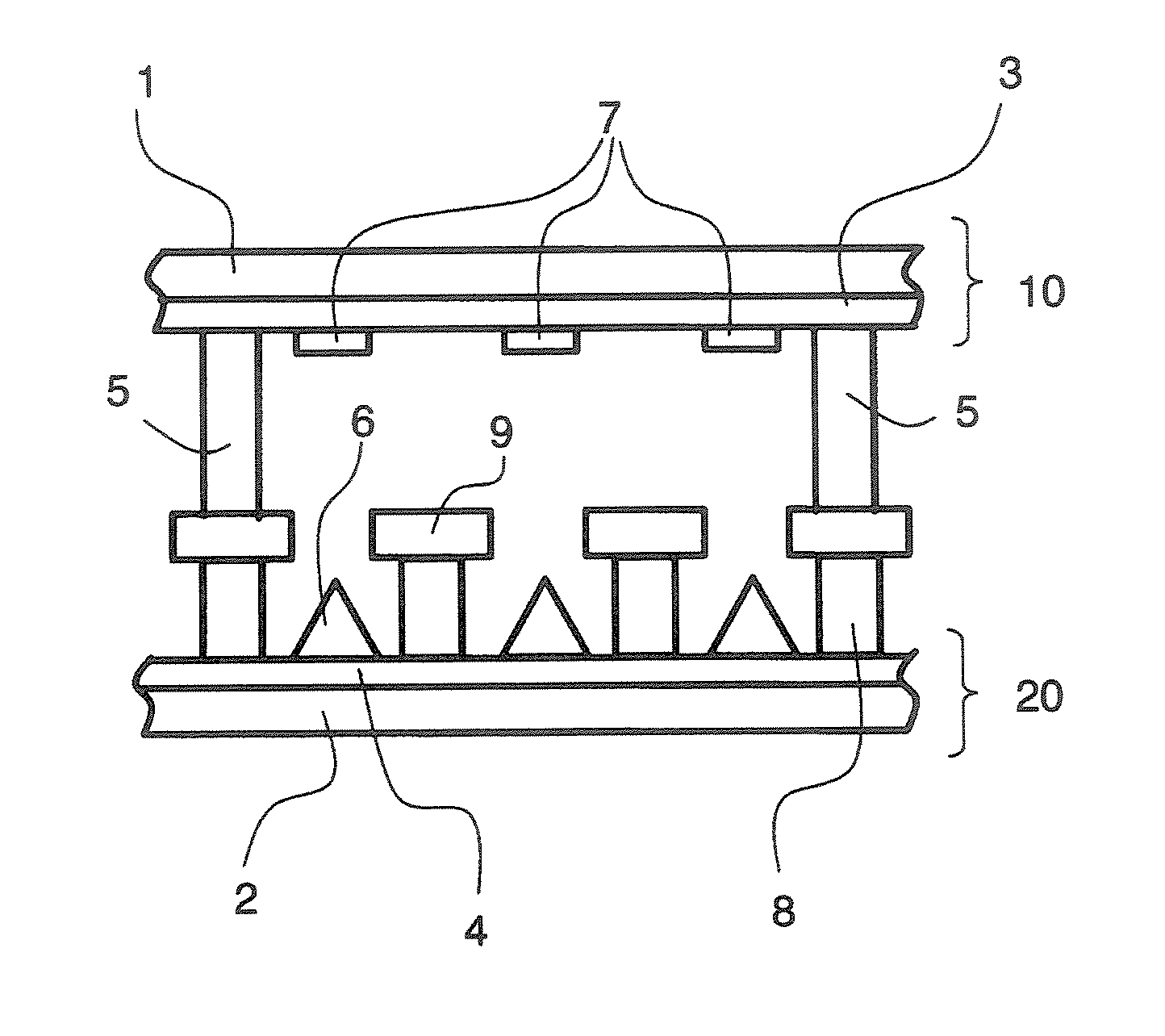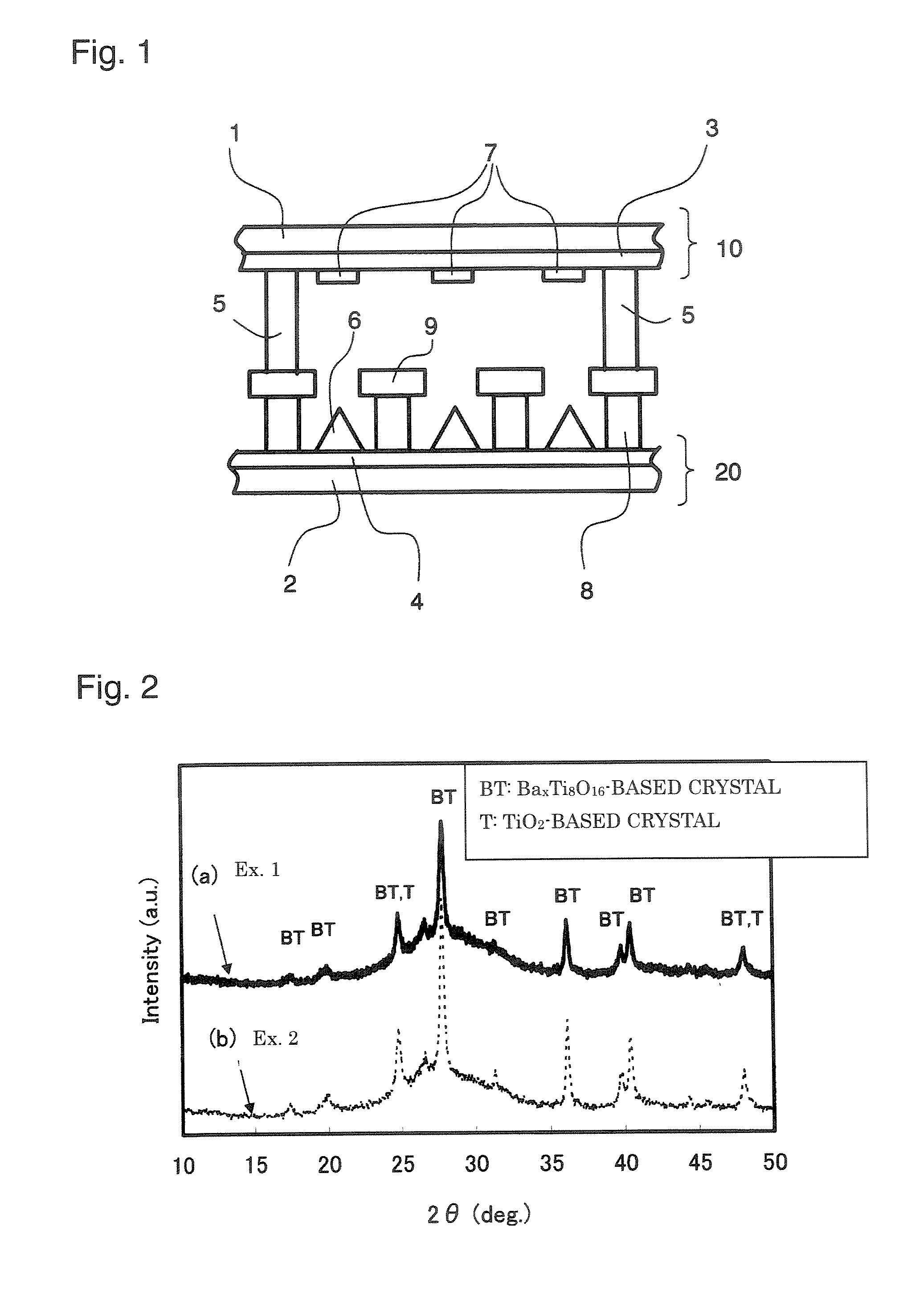Crystallized glass spacer for field emission display and method its production
- Summary
- Abstract
- Description
- Claims
- Application Information
AI Technical Summary
Benefits of technology
Problems solved by technology
Method used
Image
Examples
example 1
Example of the Present Invention
[0071] Raw materials were mixed in a composition of SiO2: 31 mol %, TiO2: 37 mol %, Al2O3: 3 mol %, CaO: 14 mol % and BaO: 15 mol %, and melted in a platinum or platinum-rhodium crucible under stirring and at 1400° C. in an air in an electric furnace for five hours. Then the molten glass was poured out to be formed into a plate, and slowly cooled.
[0072] The plate obtained by the above method was polished and cut in a size of 2×0.2×50 mm and in a shape of the spacer for the FED. Furthermore, a part of a small piece was cut into a predetermined size and polished to obtain test pieces. These processed products were introduced into a quartz tubular furnace and maintained at 740° C. for two hours under flow of hydrogen at a flow rate of 0.2 liter / min and nitrogen at a flow rate of 1.8 liters / min, and then the temperature was raised at a rate of 50° C. / hr up to 790° C. and maintained for 14 hours, whereby the reduction and crystallization heat treatment w...
example 2
Example of the Present Invention
[0075] Raw materials were mixed in a composition of SiO2: 31 mol %, TiO2: 37 mol %, Al2O3: 3 mol %, CaO: 14 mol %, and BaO: 15 mol %, and melted in a platinum or platinum-rhodium crucible under stirring and at 1400° C. in an air in an electric furnace for five hours. Then the molten glass was poured out to be formed into a plate, and slowly cooled.
[0076] The plate obtained by the above method was polished and cut in a size of 2×0.2×50 mm and in a shape of the spacer for the FED. Furthermore, a part of a small piece was cut into a predetermined size and polished to obtain test pieces. These processed products were introduced into a quartz tubular furnace and maintained at 740° C. for two hours under flow of hydrogen at a flow rate of 1.4 liters / min and nitrogen at a flow rate of 0.6 liter / min, and then the temperature was raised at a rate of 50° C. / hr up to 810° C. and maintained for 6 hours, whereby the reduction and crystallization heat treatment w...
example 3
Comparative Example
[0079] Raw materials were mixed in a composition of SiO2: 31 mol %, TiO2: 37 mol %, Al203: 3 mol %, CaO: 14 mol %, and BaO: 15 mol %, and melted in a platinum or platinum-rhodium crucible under stirring and at 1400° C. in an air in an electric furnace for five hours. Then the molten glass was poured out to be formed into a plate, and slowly cooled.
[0080] The plate obtained by the above method was polished and cut in a size of 2×0.2×50 mm and in a shape of the spacer for the FED. Furthermore, a part of a small piece was cut into a predetermined size and polished to obtain test pieces. However, no heat treatment was carried out for these processed products.
[0081] The value of fracture toughness KIC of the glass was measured and was as low as 0.62 MPa·m1 / 2, and a rate of occurrence of a chip or a crack was expected to be high when the glass was used for the spacer for the FED. Furthermore, the surface resistivity at 20° C. was 1016.2 Ω and no spacer obtained had a...
PUM
| Property | Measurement | Unit |
|---|---|---|
| Temperature | aaaaa | aaaaa |
| Temperature | aaaaa | aaaaa |
| Temperature | aaaaa | aaaaa |
Abstract
Description
Claims
Application Information
 Login to View More
Login to View More - R&D
- Intellectual Property
- Life Sciences
- Materials
- Tech Scout
- Unparalleled Data Quality
- Higher Quality Content
- 60% Fewer Hallucinations
Browse by: Latest US Patents, China's latest patents, Technical Efficacy Thesaurus, Application Domain, Technology Topic, Popular Technical Reports.
© 2025 PatSnap. All rights reserved.Legal|Privacy policy|Modern Slavery Act Transparency Statement|Sitemap|About US| Contact US: help@patsnap.com


